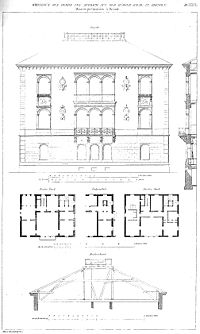
Georg Hermann Nicolai
Encyclopedia

Germany
Germany , officially the Federal Republic of Germany , is a federal parliamentary republic in Europe. The country consists of 16 states while the capital and largest city is Berlin. Germany covers an area of 357,021 km2 and has a largely temperate seasonal climate...
architect
Architect
An architect is a person trained in the planning, design and oversight of the construction of buildings. To practice architecture means to offer or render services in connection with the design and construction of a building, or group of buildings and the space within the site surrounding the...
and educator, Professor of Architecture at the Royal Academy of Fine Arts on the Brühl Terrace in Dresden
Dresden
Dresden is the capital city of the Free State of Saxony in Germany. It is situated in a valley on the River Elbe, near the Czech border. The Dresden conurbation is part of the Saxon Triangle metropolitan area....
from 1850 until his death.
Nicolai studied architecture at the Dresden
Dresden
Dresden is the capital city of the Free State of Saxony in Germany. It is situated in a valley on the River Elbe, near the Czech border. The Dresden conurbation is part of the Saxon Triangle metropolitan area....
Academy under Joseph Thürmer and later in Munich
Munich
Munich The city's motto is "" . Before 2006, it was "Weltstadt mit Herz" . Its native name, , is derived from the Old High German Munichen, meaning "by the monks' place". The city's name derives from the monks of the Benedictine order who founded the city; hence the monk depicted on the city's coat...
under Friedrich von Gärtner. Travels to Italy
Italy
Italy , officially the Italian Republic languages]] under the European Charter for Regional or Minority Languages. In each of these, Italy's official name is as follows:;;;;;;;;), is a unitary parliamentary republic in South-Central Europe. To the north it borders France, Switzerland, Austria and...
included stints in 1834-5 and 1839-40. He served as Hofbaumeister in Coburg
Coburg
Coburg is a town located on the Itz River in Bavaria, Germany. Its 2005 population was 42,015. Long one of the Thuringian states of the Wettin line, it joined with Bavaria by popular vote in 1920...
from 1841-45 and established a private practice in Frankfurt am Main from 1845-48. In mid-summer 1850 he succeeded Gottfried Semper
Gottfried Semper
Gottfried Semper was a German architect, art critic, and professor of architecture, who designed and built the Semper Opera House in Dresden between 1838 and 1841. In 1849 he took part in the May Uprising in Dresden and was put on the government's wanted list. Semper fled first to Zürich and later...
as Professor of the Bauatelier of the Dresden
Dresden
Dresden is the capital city of the Free State of Saxony in Germany. It is situated in a valley on the River Elbe, near the Czech border. The Dresden conurbation is part of the Saxon Triangle metropolitan area....
Academy of Fine Arts many months after Semper
Semper
Semper may refer to:*Semper Fidelis, a motto used by, among others, the United States Marine Corp*Semper Fortis, an unofficial motto of the United States Navy*Semper Paratus, the United States Coast Guard motto...
had participated in building a barricade in the May Uprising of the previous year. Nicolai brought a fine sensibility to the reinterpretation of Quattrocento-style Neorenaissance architecture in Dresden
Dresden
Dresden is the capital city of the Free State of Saxony in Germany. It is situated in a valley on the River Elbe, near the Czech border. The Dresden conurbation is part of the Saxon Triangle metropolitan area....
in his years at the Academy, and was an extremely popular teacher. Many of his students went on to distinguished careers in Saxony
Saxony
The Free State of Saxony is a landlocked state of Germany, contingent with Brandenburg, Saxony Anhalt, Thuringia, Bavaria, the Czech Republic and Poland. It is the tenth-largest German state in area, with of Germany's sixteen states....
and beyond. Upon his death, his former pupil Constantin Lipsius
Constantin Lipsius
Johannes Wilhelm Constantin Lipsius was a German architect and architectural theorist, best known for his controversial design of the Royal Academy of Fine Arts and Exhibition Building on the Brühl Terrace in Dresden, today known as the Lipsius-Bau.After attending Gymnasium, Lipsius initially...
(1832-1894) was named his replacement.
Principal Works
- Seebach Residence (1839)
- Villa Struve (1851-2)
- Villa Meyer (1867-69)
- Reconstruction of Prince George's Palace on the Zinzendorfstrasse (1855-7)
- Villa Seiler (1867-8)
All of these were destroyed during the Allied bombing of Dresden in World War II
Bombing of Dresden in World War II
The Bombing of Dresden was a military bombing by the British Royal Air Force and the United States Army Air Force and as part of the Allied forces between 13 February and 15 February 1945 in the Second World War...
.
English
- Berry, J. Duncan. The Legacy of Gottfried Semper: Studies in Späthistorismus (Ph. D. Diss., Brown University, 1989): pp. 124-33.
German
- Anon., Geschichte des akademischen Architekten-Club Akanthus. Gedenk-Schrift zum 30jährigen Stiftungsfeste 1894 (Dresden 1894).
- Anon., "Herrmann Georg (sic) Nicolai," Dresdner Anzeiger CLI/229 (August 17, 1881): p. 4-5.
- Helas, Volker. Sempers Dresden. Die Bauten und die Schüler (Dresden, 2003): pp. 37-39, 47 n9. ISBN 3930382954
- Lier, H. A. in: Allgemeine Deutsche Biographie 52 (1906): pp. 784-5.
- Lipsius, Constantin. "Georg Hermann Nicolai," Deutsche Bauzeitung 16 (1882): pp. 304-7, 314-7.
- Milde, Kurt. Neorenaissance in der deutschen Architektur des 19. Jahrhunderts. Grundlagen, Wesen und Gültigkeit (Dresden 1981): pp. 160-70, 225, 260.
- Neiss, A. (ed.), Architektonischen Entwürfe aus dem Atelier des Prof. Hermann Nicolai in Dresden. 2nd ed. (Berlin, n. d., [ca. 1883]).
- Nicolai, Georg Hermann. Das Ornament der italienischen Kunst des 15. Jahrhunderts. Eine Sammlung der hervorragendsten Motive (Dresden, 1882). Engl. trans. as: The Ornament of Italian Art of the XV. Century. A Collection of Superior Specimens (New York, 1914).

